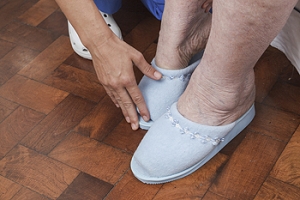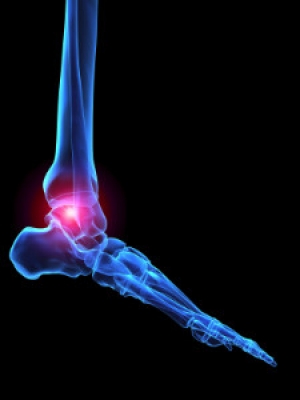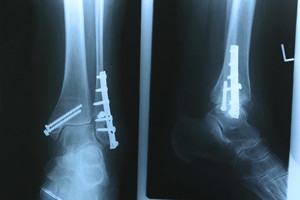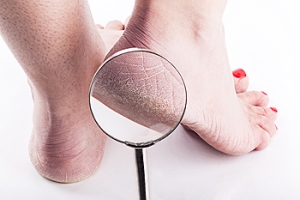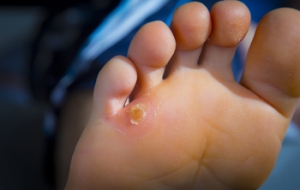Connect With Us

It’s Important to Check the Bottom of the Feet on Elderly Patients
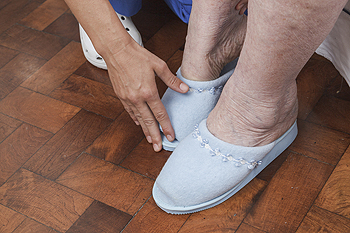 Foot pain is common among the elderly population. It can gradually occur for a variety of reasons which can include medical conditions such as diabetes, arthritis, or complications with circulation. Research has indicated the importance for older people to check the conditions of their feet on a daily basis, as this may be helpful in avoiding unpleasant foot ailments. One of the methods that can be practiced in maintaining good foot health includes checking the bottom of the feet for cuts, bruises, or wounds. Additionally, it is beneficial to check what type of shoes are worn, and to ensure there is adequate room for the toes to move freely in. If you would like additional information on what to look for in elderly patient's feet, please consult with a podiatrist.
Foot pain is common among the elderly population. It can gradually occur for a variety of reasons which can include medical conditions such as diabetes, arthritis, or complications with circulation. Research has indicated the importance for older people to check the conditions of their feet on a daily basis, as this may be helpful in avoiding unpleasant foot ailments. One of the methods that can be practiced in maintaining good foot health includes checking the bottom of the feet for cuts, bruises, or wounds. Additionally, it is beneficial to check what type of shoes are worn, and to ensure there is adequate room for the toes to move freely in. If you would like additional information on what to look for in elderly patient's feet, please consult with a podiatrist.
Proper foot care is something many older adults forget to consider. If you have any concerns about your feet and ankles, contact Dr. Richard Silverstein from Union Foot Care. Our doctor can provide the care you need to keep you pain-free and on your feet.
The Elderly and Their Feet
As we age we start to notice many changes in our body, but the elder population may not notice them right away. Medical conditions may prevent the elderly to take notice of their foot health right away. Poor vision is a lead contributor to not taking action for the elderly.
Common Conditions
- Neuropathy – can reduce feeling in the feet and can hide many life-threatening medical conditions.
- Reduced flexibility – prevents the ability of proper toenail trimming, and foot cleaning. If left untreated, it may lead to further medical issues.
- Foot sores – amongst the older population can be serious before they are discovered. Some of the problematic conditions they may face are:
- Gouging toenails affecting nearby toe
- Shoes that don’t fit properly
- Pressure sores
- Loss of circulation in legs & feet
- Edema & swelling of feet and ankles
Susceptible Infections
Diabetes and poor circulation can cause general loss of sensitivity over the years, turning a simple cut into a serious issue.
If you have any questions please feel free to contact our office located in Havre de Grace, MD . We offer the newest diagnostic and treatment technologies for all your foot and ankle needs.
Taking Care of Elderly Feet
Many foot diseases and conditions become more serious and common among the elderly. Some of these conditions include diabetic ulcers, ingrown toenails, fungus, arthritis, corns, and calluses. Unfortunately, it may be harder for older adults to take care of their own feet, but there are some precautions they can take in order to avoid any serious conditions.
Dry, cracked heels tend to be a common problem for older people. In order to avoid this, you should always keep your feet clean and well moisturized. Special feet moisturizers should be used as average lotions might not provide enough moisture for dry and cracked heels. Daily foot inspections are crucial for the elderly to detect any irregularities in their earliest stages. During the aging process, blood circulation tends to slow down causing older people to not feel their feet as well as they used to. This often results in foot problems going unnoticed.
Fungal and bacterial conditions thrive on elderly feet because older adults are less likely to keep their feet clean and dry; this makes it easier for bacteria to take hold in their dry, cracked skin. Elderly people should be sure to thoroughly dry their feet, especially in between the toes, after bathing. This will help them avoid developing any fungal infections. Additionally, clean cotton socks should be worn after the feet are dried.
Cutting toenails straight across will help prevent ingrown toenails. When toenails are cut too lose, the nail might break through the skin resulting in an ingrown nail. Clippers should be used to cut the nails in order to make the cut even.
Elderly people who have diabetes are at risk of developing serious foot problems that may lead to amputation. Ulcers that are left untreated can lead to gangrene. Dry and cracked feet, fungus, and untended cuts under the nails may also lead to infections.
Fortunately, Medicare covers many different types of services for foot care. Elderly people with any of these foot conditions should seek the help of a podiatrist and perform daily foot inspections in order to ensure that they have healthy feet.
Types of Arthritis in the Feet
 Research has indicated that a common cause of foot pain is inflammation. This may be a result of arthritis, and could happen from an immune disorder. Gout is a painful foot condition, and is considered to be a form of arthritis. It occurs as a result of excess uric acid levels in the blood, and may be caused by eating foods that have high purine levels. Psoriasis is a skin condition which may cause psoriatic arthritis, and the joints, tendons, and ligaments are often impacted. If you are experiencing pain in your feet, it is necessary to receive prompt and effective treatment. It is suggested that you consult with a podiatrist as quickly as possible to properly diagnose this ailment, and to help you find relief.
Research has indicated that a common cause of foot pain is inflammation. This may be a result of arthritis, and could happen from an immune disorder. Gout is a painful foot condition, and is considered to be a form of arthritis. It occurs as a result of excess uric acid levels in the blood, and may be caused by eating foods that have high purine levels. Psoriasis is a skin condition which may cause psoriatic arthritis, and the joints, tendons, and ligaments are often impacted. If you are experiencing pain in your feet, it is necessary to receive prompt and effective treatment. It is suggested that you consult with a podiatrist as quickly as possible to properly diagnose this ailment, and to help you find relief.
Arthritis can be a difficult condition to live with. If you are seeking treatment, contact Dr. Richard Silverstein from Union Foot Care. Our doctor can provide the care you need to keep you pain-free and on your feet.
Arthritic Foot Care
Arthritis is a term that is commonly used to describe joint pain. The condition itself can occur to anyone of any age, race, or gender, and there are over 100 types of it. Nevertheless, arthritis is more commonly found in women compared to men, and it is also more prevalent in those who are overweight. The causes of arthritis vary depending on which type of arthritis you have. Osteoarthritis for example, is often caused by injury, while rheumatoid arthritis is caused by a misdirected immune system.
Symptoms
- Swelling
- Pain
- Stiffness
- Decreased Range of Motion
Arthritic symptoms range in severity, and they may come and go. Some symptoms stay the same for several years but could potentially get worse with time. Severe cases of arthritis can prevent its sufferers from performing daily activities and make walking difficult.
Risk Factors
- Occupation – Occupations requiring repetitive knee movements have been linked to osteoarthritis
- Obesity – Excess weight can contribute to osteoarthritis development
- Infection – Microbial agents can infect the joints and trigger arthritis
- Joint Injuries – Damage to joints may lead to osteoarthritis
- Age – Risk increases with age
- Gender –Most types are more common in women
- Genetics – Arthritis can be hereditary
If you suspect your arthritis is affecting your feet, it is crucial that you see a podiatrist immediately. Your doctor will be able to address your specific case and help you decide which treatment method is best for you.
If you have any questions, please feel free to contact our office located in Havre de Grace, MD . We offer the newest diagnostic and treatment technologies for all your foot care needs.
How to Care for Your Arthritic Foot
Arthritis is an inflammation of the joints and it can occur at any joint in the body, especially in the foot. It generally effects those who are older, however, it can occur at any age. Although there are many different forms of arthritis, there are three main types that occur in the foot. The three types are osteoarthritis, rheumatoid arthritis, and gout.
The primary cause of osteoarthritis is aging. As you age, cartilage degenerates around the joints which causes friction and pain. Obesity can cause osteoarthritis through mechanical stress. Injuries that damage joints can increase the probability as well. Finally, a family history of osteoarthritis can also increase chances of having it.
Rheumatoid arthritis occurs when the immune system attacks the joint linings and weakens them over a long time. While there is no known cause of rheumatoid arthritis, obesity and smoking can increase your chances of getting it. Women are also more likely to get it than men.
Gout is a form of arthritis that occurs when there is too much uric acid in your blood and painful crystals form in your joints. Men are more likely to have gout than women. People who are obese or drink alcohol often are also more likely to develop gout. Furthermore, having diabetes, heart disease, high blood pressure, high cholesterol, gastric bypass surgery or a family history of gout may increase your likelihood of developing the condition.
Symptoms of arthritis include pain, stiffness, swelling in the joints. These symptoms can make it harder and more painful to walk. Physical activity can increase pain and discomfort. Furthermore, joint pain can worsen throughout the day for osteoarthritis. Gout attacks generally last several days with the first few being the worst.
Diagnosis of gout includes either a joint fluid test or a blood test. X-ray imaging can detect osteoarthritis but not gout. On the other hand, there is no blood test for osteoarthritis. Rheumatoid arthritis is difficult to diagnosis. Doctors utilize family and personal medical history, a physical examination, and antibody blood tests to determine if you have rheumatoid arthritis.
Treatment varies for the different kinds of arthritis. Anti-inflammatory medication or steroids can help reduce pain from inflammation of the joints. Changing shoe types can help with some symptoms. Wider shoes can help with discomfort from gout and osteoarthritis. High heels should be avoided. Shoes with proper arch support and that take pressure off the ball of the foot can help with rheumatoid arthritis. Drinking lots of water can also help rid uric acid from the blood. Losing weight, improving your diet, and limiting alcohol and smoking can also help prevent or lessen the symptoms of arthritis.
If you are having trouble walking or pain in your feet, see a podiatrist to check if you have arthritis.
Understanding the Basics of Stress Fractures
 Stress fractures primarily occur when the feet are overused. As foot muscles get tired, they are unable to absorb as much shock from impact, and the stress is transferred to the bone. Over half of all stress fractures occur in the lower leg, and athletes involved in activities such as basketball, running, and gymnastics are at a higher risk for trauma. Since stress fractures can be difficult to diagnose through an X-Ray, communicating the risk of stress fractures to doctors is key, because they may have to resort to CT scans or MRIs. If diagnosed with a stress factor, rest is key. However, a podiatrist may be able to recommend shoe inserts or braces to help as well. For the best treatment methods, please consult with your local podiatrist.
Stress fractures primarily occur when the feet are overused. As foot muscles get tired, they are unable to absorb as much shock from impact, and the stress is transferred to the bone. Over half of all stress fractures occur in the lower leg, and athletes involved in activities such as basketball, running, and gymnastics are at a higher risk for trauma. Since stress fractures can be difficult to diagnose through an X-Ray, communicating the risk of stress fractures to doctors is key, because they may have to resort to CT scans or MRIs. If diagnosed with a stress factor, rest is key. However, a podiatrist may be able to recommend shoe inserts or braces to help as well. For the best treatment methods, please consult with your local podiatrist.
Stress fractures occur when there is a tiny crack within a bone. To learn more, contact Dr. Richard Silverstein from Union Foot Care. Our doctor can provide the care you need to keep you pain free and on your feet.
How Are They Caused?
Stress fractures are the result of repetitive force being placed on the bone. Since the lower leg and feet often carry most of the body’s weight, stress fractures are likely to occur in these areas. If you rush into a new exercise, you are more likely to develop a stress fracture since you are starting too much, too soon. Pain resulting from stress fractures may go unnoticed at first, however it may start to worsen over time.
Risk Factors
- Gender – They are more commonly found in women compared to men.
- Foot Problems – People with unusual arches in their feet are more likely to develop stress fractures.
- Certain Sports – Dancers, gymnasts, tennis players, runners, and basketball players are more likely to develop stress fractures.
- Lack of Nutrients – A lack of vitamin D and calcium may weaken the bones and make you more prone to stress fractures
- Weak Bones – Osteoporosis can weaken the bones therefore resulting in stress fractures
Stress fractures do not always heal properly, so it is important that you seek help from a podiatrist if you suspect you may have one. Ignoring your stress fracture may cause it to worsen, and you may develop chronic pain as well as additional fractures.
If you have any questions, please feel free to contact our office located in Havre de Grace, MD . We offer the newest diagnostic and treatment technologies for all your foot care needs.
Stress Fractures of the Foot and Ankle
Our bones are important aspects of our body and they are constantly changing. The heavier the workload for a bone, the more likely it is that calcium will be placed in it. When a bone isn’t used often, there won’t be much calcium within it. When stress from repetitive loads prevent the bone from being able to repair itself, cracks will start to form. Stress fractures are defined as cracks in a bone that result from repetitive force, such as overuse.
The most common cause of stress fractures is a sudden increase in intensity and duration of physical activity. For example, if you begin to run long distances without working your way into doing so, you will be more likely to develop a stress fracture.
Common symptoms of stress fractures are pain and swelling near the weight bearing area on the injured bone. When initial x-rays are performed, it is possible that the fracture will not show up. However, once the stress on the area continues, the damage will increase, and the fracture will be severe enough to show up on an x-ray. Certain parts of the foot are more likely to develop stress fractures than others. Areas that typically have these fractures are: the metatarsals, the navicular bone, the calcaneus, tibia, and fibula.
Since women are at an increased risk of developing osteoporosis, they are twice as likely as men to sustain a stress fracture. Additionally, old age causes a decrease in bone mineral density which is why elderly people are also likely to develop these fractures.
It is important for you to be professionally diagnosed by a podiatrist if you suspect you have a stress fracture, because there are other injuries that can easily be mistaken for a fracture. Sprains, strains, shin splints, plantar fasciitis, and Morton’s neuroma can all easily be mistaken for stress fractures in the foot. Your podiatrist will likely ask you a series of questions to determine what type of pain you are experiencing. These questions will help your doctor identify whether you have a stress fracture.
The best method of treatment for a stress fracture is rest. Additionally, a walking boot, cast, or crutches, will help rest the area that is injured. The typical healing time for stress fractures is 4-12 weeks, however this depends on which bone is involved.
Treating Cracked Heels
 Cracked heels, while physically embarrassing, can also bring a great deal of discomfort and pain to the affected foot. Some common causes of cracked heels may include open-back footwear, weather, and improper skin care. To help remove the dry skin, use a filer and gently scrape the areas that are hardened. Exfoliating, washing, and thoroughly drying the feet may also be beneficial to treating cracked heels. Using a daily moisturizer can also help to ease the discomfort of cracked heels, and it keeps the skin hydrated. In order to safely treat and heal cracked feet, seek the care of your podiatrist.
Cracked heels, while physically embarrassing, can also bring a great deal of discomfort and pain to the affected foot. Some common causes of cracked heels may include open-back footwear, weather, and improper skin care. To help remove the dry skin, use a filer and gently scrape the areas that are hardened. Exfoliating, washing, and thoroughly drying the feet may also be beneficial to treating cracked heels. Using a daily moisturizer can also help to ease the discomfort of cracked heels, and it keeps the skin hydrated. In order to safely treat and heal cracked feet, seek the care of your podiatrist.
Cracked heels are unsightly and can cause further damage to your shoes and feet. If you have any concerns, contact Dr. Richard Silverstein from Union Foot Care. Our doctor can provide the care you need to keep you pain-free and on your feet.
Cracked Heels
Cracked heels appear unappealing and can make it harder for you walk around in sandals. Aside from looking unpleasant, cracked heels can also tear stockings, socks, and wear out your shoes. There are several methods to help restore a cracked heel and prevent further damage.
How Do You Get Them?
Dry skin is the number one culprit in creating cracked heels. Many athletes, walkers, joggers, and even swimmers suffer from cracked heels. Age and skin oil production play a role to getting cracked heels as well.
Promote Healing
Over the counter medicines can help, especially for those that need instant relief or who suffer from chronic dry feet.
Wear Socks – Wearing socks with medicated creams helps lock in moisture.
Moisturizers – Applying both day and night will help alleviate dryness which causes cracking.
Pumice Stones – These exfoliate and remove dead skin, which allows for smoother moisturizer application and better absorption into the skin.
Change in Diet
Eating healthy with a well-balanced diet will give the skin a fresh and radiant look. Your body responds to the kinds of food you ingest. Omega-3 fatty acids and zinc supplements can also revitalize skin tissue.
Most importantly, seek professional help if unsure how to proceed in treating cracked heels. A podiatrist will help you with any questions or information needed.
If you have any questions, please feel free to contact our office located in Havre de Grace, MD . We offer the newest diagnostic and treatment technologies for all your foot care needs.
Solutions for Cracked Heels
Cracked heels may make you want to think twice about showing off your feet in warmer weather. However, cracked heels may be harmful to more than just the appearance of your feet. If deep fissures and cracks develop in your heels, they may make walking and standing painful for you. Additionally, these openings make way for germs to enter through your skin and cause infection.
There are several different causes of cracked heels. One of the most common reasons for this ailment is dry skin. This problem may make your keeps feel rough tight and itchy. Dry skin may be caused by cold air, extremely hot water, harsh soaps, and aging. Skin disorders such as eczema and psoriasis may eventually lead to dry skin. In some cases, complications may arise from cracked heels. Some of these complications are a loss of feeling in the heel, cellulitis, or a diabetic foot ulcer.
There are ways you can try to prevent getting cracked heels. One of the best ways to do so is to avoid wearing flip flops and sandals because these shoes increase your risk of drying out your feet. You should also avoid wearing shoes with a tall skinny heel, because these shoes cause your heel to expand sideways. At night, you should slather on a thick moisturizing cream on your feet and then cover them in socks to keep your feet moisturized overnight. Drinking water to stay hydrated is also a good way to ensure that your skin doesn’t become dry.
If you suffer from a severe case of cracked feet, you should make an appointment with your podiatrist to see what treatment methods are best for you.
Three Types of Corns
 The definition of a corn is a small hardened patch of skin on the sole of the foot that generally develops as a result of excess friction. The types of corns that form on the feet are categorized as either hard, soft, or seed. Hard is considered to be the most common type of corn, and can be found on top of the toes or on the bottom of the feet. Soft corns are typically found between the toes, and can cause pain and discomfort. The skin can become inflamed, and it may be difficult to wear shoes. Clogged sweat glands may produce seed corns, which can appear on the bottom of the feet. Most corns can be prevented by wearing shoes that fit correctly, in addition to trimming the toenails correctly. Mild relief can be found if a corn pad is worn, as this may provide a protection barrier for existing corns. If you have developed any type of corn, it is strongly suggested that you consult with a podiatrist who can help you to manage this condition.
The definition of a corn is a small hardened patch of skin on the sole of the foot that generally develops as a result of excess friction. The types of corns that form on the feet are categorized as either hard, soft, or seed. Hard is considered to be the most common type of corn, and can be found on top of the toes or on the bottom of the feet. Soft corns are typically found between the toes, and can cause pain and discomfort. The skin can become inflamed, and it may be difficult to wear shoes. Clogged sweat glands may produce seed corns, which can appear on the bottom of the feet. Most corns can be prevented by wearing shoes that fit correctly, in addition to trimming the toenails correctly. Mild relief can be found if a corn pad is worn, as this may provide a protection barrier for existing corns. If you have developed any type of corn, it is strongly suggested that you consult with a podiatrist who can help you to manage this condition.
If you have any concerns regarding your feet and ankles, contact Dr. Richard Silverstein of Union Foot Care. Our doctor will treat your foot and ankle needs.
Corns: What Are They? and How Do You Get Rid of Them?
Corns can be described as areas of the skin that have thickened to the point of becoming painful or irritating. They are often layers and layers of the skin that have become dry and rough, and are normally smaller than calluses.
Ways to Prevent Corns
There are many ways to get rid of painful corns such as wearing:
- Well-fitting socks
- Comfortable shoes that are not tight around your foot
- Shoes that offer support
Treating Corns
Treatment of corns involves removing the dead skin that has built up in the specific area of the foot. Consult with Our doctor to determine the best treatment option for your case of corns.
If you have any questions please feel free to contact our office located in Havre de Grace, MD . We offer the newest diagnostic and treatment technologies for all your foot and ankle needs.


